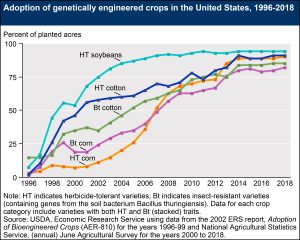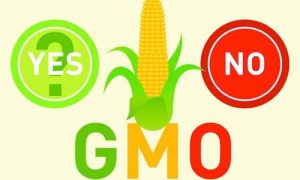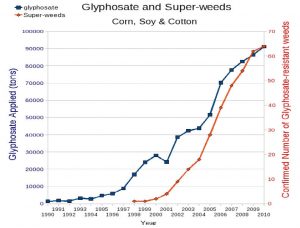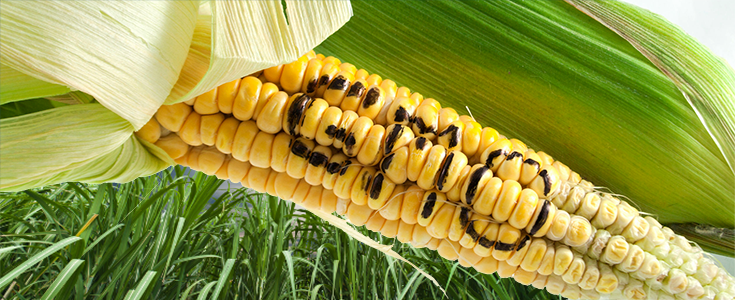
Genetically Modified Organisms (GMOs) are any type of animal, plant, or microbe in which the DNA has been changed through the use of genetic engineering techniques. These kinds of genome modifying techniques are used widely in the world of biological research and the development of GMOs can be broken down into four different steps. First, a specific trait or genome is identified for a desirable use. Next, that genomic attribute is isolated by either forms of comparative analysis, or simply removing different parts of the genome until the preference trait is removed. Following isolation, the wanted trait then proceeds to be inserted into a new genome. Lastly, the newly modified organisms are grown and cultivated like crops in a field. It is also important to distinguish GMOs from transgenic organisms. Transgenic organisms are those in which a species genome has been altered by applying DNA from a separate species to the targeted organism. While their DNA is also being modified, GMOs differentiate themselves from transgenic organisms in that the only DNA being implemented already comes from the genome of the desired organism.
While mankind has been exploring the effects of altering nature through methods such as animal and plant breeding for thousands of years, the first successful creation of a GMO came in 1973 by Herbert Boyer and Stanley Cohen. With the help of Paul Berg’s research on gene splicing in 1971, Hebert and Cohen were able to develop the first GMO by inserting plasmid DNA into bacteria (U.S. Food and Drug Administration., 2020). This discovery took the world by storm and it was not long before the first FDA approved genetically engineered form of insulin became available to the general public. From that point on GMOs began to spring up in all forms leading to the foundational approval by the U.S. Food and Drug Administration of the Flavr Savr tomato product. Since this integration the evolution of GMOs has rapidly grown and has led to markets like agriculture, produce, and medicine being dominated by such products. However, many people question the safety of GMOs and what the long term results could look like. In a skeptical world where the truth can often seem fabricated, the question to be asked is what are the positive and negative effects of GMOs and what does that look like in modern society.

Advantages of GMOs
As shown by Figure 1, the adopted usage of genetically modified crops has increased steadily over time. The first example of how GMOs benefit the world is shown in the field of medicine. Genetically modified animals are able to be models for genetic diseases in humans and allow for the development of new treatment options. The revolution of GMOs has also benefited pharmaceuticals by giving new paths to more cost efficient and safe forms of medicine in instances like vaccines. In many cases needles make people uneasy, but through the use of genetic engineering some types of vaccines are being made in an edible form. This works in that genetically modified plants essentially serve as biofactories and are developed to contain structural proteins of viruses that then allow for antigen sequences to generate immunization responses in the body. An example comes from the 1990s when there was a major issue of ringspot virus disease that had been decimating papaya plants in Hawaii (Norero D., 2020). A genetically modified form of papaya was created to resist the effects of this virus and allowed for the repopulation of these crops (FDA., 2020).
Another way GMOs are being used, and probably the most publicly recognizable method of GMOs benefiting society is their utilization in agriculture. In the United States alone, over 90% of all crops harvested and sold are genetically modified in some way (Aid, F., 2016). GMOs also have a reputation for being very environmentally friendly. The use of genetic engineering has allowed for fewer crops to be planted and yield bigger results. By planting less this means things like fewer water being used, improving soil health, more biodiversity, and less pollution from farming equipment. Diving deeper into the genetically modified agriculture environment, there are several focuses to be explored. With the higher yield percentages of crops, the use of pesticides should in theory be lessened. Now that these virus and/or fungi resistant crops have been implemented as one of the major sources of food in society, they are able to have the effect of less pollution. In fact, there are several types of organisms that are able to break down pollutants like sewage, metals, and even nuclear waste. Usually getting rid of waste products has its own negative factors associated. However, with genetically modified crops allowing for longer lasting products and fewer regulatory maintenance, they appear to most people as the better option.
GMOs more often than not lead to cheaper options at the produce market. Since farmers are able to yield more product in a much more cost efficient way, it allows for grocery store prices to be lower and more options to be had. Not only does this help reduce the struggle against world hunger, but in many cases the GMO containing food is viewed as better tasting. Although most people consume some form of genetically modified produce everyday, because the average person knows little about them there is a certain uneasiness that arises when the topic of GMOs is brought up. Regulation laws and risk assessment studies into the effects of GMOs have been conducted to ensure their safety (McHughen, A., 2007). With new innovations often being scrutinized, the legislation process associated with GMOs has gone through extensive investigative procedures.

Potential Risk Effects of GMOs
Although GMOs have been crucial to the growth and sustainment of the modern world, there are some negative consequences that do and possibly will come in the future. One of the main reasons many people are skeptical about GMOs is because the long term effects of these products are unknown. The results of consuming these GMOs could have anywhere from no effect at all to the potential of causing some serious damage. In worse case scenarios the long term usage and consumption of GMOs could have the potential to alter DNA leading to things like allergy development, antibiotic resistance, or even cancer (Latham, J., 2019). While this is all obviously speculative, the point to take away is that nobody knows what the ramifications of this modified generation of products could be. Although this could be possible it is not like there have not been cautionary procedures taken to ensure the safety of GMOs. An example of this would be numerous GMO risk assessment studies. The problem with these studies is that many are often sloppily written with only trivial questions being asked. A large number of these assessments are also lacking critical information like control groups or procedures and end with ambiguous conclusions. As a result of this the government officials who control the regulations and use of GMOs are faced with the challenge of examining the data and ultimately being subjected to trusting whatever the research claims (Teferra, T. F., 2021). Furthermore, the usage of GMOs also has more general reverberations. Certain religious belief systems disapprove of GMOs because their modifications leave them to be viewed as unnatural. This can lead to circumstances where the capacity of food choices available are decreased. Also, and especially when GMOs were first being used, if the modifications were performed wrongly it could have resulted in failed crop yields. With crop yields failing it only adds to the cost of the already harsh agriculture environments experienced by farmers, and leads to less crops being produced.
One of the biggest benefits of GMOs is their contribution to the betterment of agriculture. However, there are also some consequences that come with this. An example of this would be the use of herbicides. Primarily herbicides are used to destroy unwanted plants to make more room for the desirable vegetation. With this in mind, most of the GMO crops have been modified to be impervious to incredibly high levels of herbicides. These modifications have essentially allowed for the drowning of fields in these chemicals (Latham, J., 2019). The same can be said for pesticide resistant GMO crops. Some might even argue that the pesticide usage could be worse since it targets unwanted living things whereas herbicides specifically focus on particular plants. In some cases because of the heavy chemical usage, once these crops have been harvested it can result in thousands of damaged and unhealthy acres of soil where almost nothing grows. While the consumption of these crops being doused in poisonous chemicals is obviously not ideal, it is not the main problem. Unintended results like washing into bodies of water or spreading into the atmosphere are the real issue concerning the usage of these chemicals. With so many people adopting this GMO strategy, this potential of unhealthy farming has been on the rise.
Another problem concerning the use of GMOs for many people is the companies producing them. Since the introduction of GMOs into the industry, a select group of four companies (Monsanto, Dupont, Syngenta and Dow) have emerged to produce over 60% of the seeds in the world (Aid, F., 2016). Not only has this caused farmers profits to take a hit, but the cost per acre has left margins smaller than ever. Probably the most known herbicide associated with GMOs is known as Roundup and comes from the company Monsanto. The issue with Roundup is that it contains a molecule known as glyphosate. Glyphosate is a problematic molecule that causes damage to the immune system and therefore leaving people more susceptible to sickness. The primary issue associated with glyphosate is its linkage to the cause of Non-Hodgkin Lymphoma (Medical News., 2021). Originally glyphosate was said to only target enzymes found in plants. However, these glyphosate targeted enzymes are present in people and animals. These enzymes are responsible for many important bodily functions like maintaining the immune system, brain function, and the digestive system (Latham, J., 2019). Since the introduction of Roundup into the world millions of tons of herbicides/pesticides have been sprayed all over the world. Because of this there have been hundreds of thousands of lawsuits brought up against roundup resulting in billions of dollars being paid in settlement (Medical News., 2021). This proof of wrongdoing has increased public skepticism associated with GMO usage.
Conclusion
There are many arguments and statistics to back up either side regarding the usage of GMOs in today’s society. Examples of this criteria include the ability of the GMO industry to improve or worsen pollution, further modernize or cripple our food economies, and overall improve or worsen life expectancy. While I trust that our bodies are well enough equipped to handle most if not all the current GMO products available at the moment, I feel the real issues are the ones that come along with genetically altered products. I think it can be unanimously agreed upon that the potential for any sort of harmful material being introduced and/or spread into the environment is bad. Although the development of genetically altered crops have allowed for the ability to use less pesticides and herbicides, it is common in many cases for the reverse effect to occur. Like previously stated, the overuse of these chemicals can have drastic results like damaging soil and polluting water sources. One thing the planet does not need is more pollution. Because of this I believe the world needs to search for a better alternative or at least less spraying of harmful chemicals. It is clear that GMOs are not going away anytime soon. In fact, the usage of genetically altered organisms will most likely continue on its upward trend. Because of this I believe the solution is to spread awareness and educate people on what they are putting into their bodies. Ultimately the choice on whether GMOs are good or bad is up to each individual. Because of this I feel it is important for people to become more mindful of their options. Just like in the nineteenth century when food production was pushed further by the industrialization of agriculture, the GMO market for crops, produce, and medicine could benefit from more labeling information and regulations. Lastly, I urge individuals to come together on issues of uncertainty. Everyone is in this world together and when potential problems arise I feel it is necessary to face said topics as a united front.
Works Cited
Aid, F. (2016, March 17). GMOs — Top five concerns for family farmers. Farm Aid. https://www.farmaid.org/issues/gmos/gmos-top-5-concerns-for-family-farmers/#:~:text=Since%20the%20commercial%20introduction%20of%20GMOs%2C%20the%20seed
FDA. (2020). GMO crops, animal food, and beyond. GMO Crops, Animal Food, and Beyond. https://www.fda.gov/food/agricultural-biotechnology/gmo-crops-animal-food-and-beyond
U.S. Food and Drug Administration. (2020). Science and History of GMOs and Other Food Modification Processes. Science and History of GMOs and Other Food Modification Processes. https://www.fda.gov/food/agricultural-biotechnology/science-and-history-gmos-and-other-food-modification-processes
Latham, J. (2019, January 7). GMO Dangers: Facts You Need to Know – Center for Nutrition Studies. Center for Nutrition Studies. https://nutritionstudies.org/gmo-dangers-facts-you-need-to-know/
Macmillan, Steven Sanity Prevails: Scotland to Ban the Cultivation of GMO Crops | New Eastern Outlook. (n.d.). Journal-Neo.org. Retrieved November 12, 2022, from https://journal-neo.org/2015/09/06/sanity-prevails-scotland-to-ban-the-cultivation-of-gmo-crops/
McHughen, A., & Smyth, S. (2007). US regulatory system for genetically modified [genetically modified organism (GMO), rDNA or transgenic] crop cultivars. Plant Biotechnology Journal, 0(0), 071024233955001-??? https://doi.org/10.1111/j.1467-7652.2007.00300.x
N.L. Swanson GMO Crops Increase Pesticide Use. (2013, September 20). Farm Wars. http://farmwars.info/?p=11515
Norero D. (2020, May 6). GMO tomato as edible COVID vaccine? Mexican scientists work to make it a reality. (n.d.). Alliance for Science. https://allianceforscience.cornell.edu/blog/2020/05/gmo-tomato-as-edible-covid-vaccine-mexican-scientists-work-to-make-it-a-reality/
Powell, C. (2015, August 9). How to Make a GMO. Science in the News; Harvard University. https://sitn.hms.harvard.edu/flash/2015/how-to-make-a-gmo/
Teferra, T. F. (2021). Should we still worry about the safety of GMO foods? Why and why not? A review. Food Science & Nutrition, 9(9). https://doi.org/10.1002/fsn3.2499
Weed killer: Glyphosate and cancer risk. (2021, September 20). Www.medicalnewstoday.com. https://www.medicalnewstoday.com/articles/does-roundup-cause-cancer
13 Pros And Cons Of GMOs (Backed By Evidence) – In On Around. (n.d.). Retrieved October 17, 2022, from https://www.inonaround.org/gmos/



10 comments
Carlene Smith
Very informative. You really did your research.
Alexandra Ballard
My mom has always been skeptical about GMOs and pushed that same apprehension onto me at a young age. I used to research this topic a lot! Some of the research done on lab animals fed GMOs suggested they do have negative effects. I didn’t know the effects on humans have been so surface researched. I guess as you stated, there hasn’t been enough time to really see if there will be adverse effects on our health. Hopefully, it’s not like with cigarettes where we find out too late to save our own generation.
Karly West
Given GMO’s are becoming more and more commonly debated, this was a great topic to choose! They are definitely not going anywhere whether we like it or not. More research definitely needs to take place in order for the general public to begin to trust them. We don’t know their overall long-term impact on our bodies and our agriculture, so I can see why there is controversy surrounding the topic. Overall very interesting article!
Gabriella Galdeano
I loved the writing in this article. All of the information was really easy to understand. I have heard about GMOs in agriculture, but I did not know that they have been involved in the making of vaccines. An edible vaccine would benefit people that are, like my friend, afraid of needles. Society has also benefited from GMOs in agriculture, but you are right in saying that something needs to be done about the pollution from herbicides and pesticides due to farming. As a society, we need to be taking better care of our environment.
Jocelyn Elias
Congratulations on your nomination. Moving on you bring a really sensitive issue into light when discussing GMOs like stated in your article yes GMOs help us but I won’t risk do we take this chemical into our digestive systems. Although it is a risk it is a necessity in today’s world in order to keep up with the demands of the population, great article.
Alyssa Leos
First of all I want to say congratulations on your article being nominated for an award. When learning about GMOs in highschool, I never really grasped the information. It was always because it was too much information that I didn’t think I needed to know. After reading your article, it brought to my attention how important it is to distinguish GMOs from transgenic organisms. Again congratulations on your article being nominated.
Alia Hernandez Daraiseh
This was an amazing and well-written article, it flowed very well and I was able to retain all information given to me. Congratulations on getting it published and nominated, it was well deserved as it is apparent how much time and effort you dedicated to this article.
Helena Griffith
Howdy, Dylan! Thank you for the nomination! I can tell that you spent a lot of time on this topic and conducted much research. GMOs, in my opinion, are a topic of discussion and controversy that is growing in popularity. For me to trust GMOs, I believe there needs to be a lot more research done. I think there must be some sort of adverse impact on us that we haven’t yet identified. Amazing work!
Laura Poole
Hello Dylan! Congratulations on your nomination! I can tell you put in a lot of time and deep research into this article. I think GMOs are becoming and increasingly popular conversation and controversy! I think there need to be way more research done on GMOs for me to trust them. I believe there has to be some sort of negative effect on us that we just haven’t discovered yet. Great work!
Halie Estrada
This was such a informative article, I recently had a farmer come in to my class to talk to us about his job and his daily life. What I didn’t know is technology is becoming more mainstream in agriculture and making feeding the people much quicker and efficient. During the talk he touched on the fact that many of the cows are artificially inseminated and the genes are modified so that the meat is better and healthier for us. So I agree when you say that GMO is going nowhere, I think it’s a great thing but the risks are there; I just think we need more information on the long-lasting effects. More research = more knowledge.